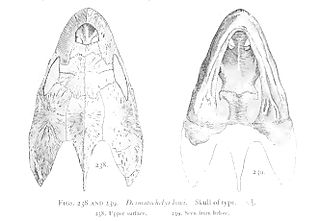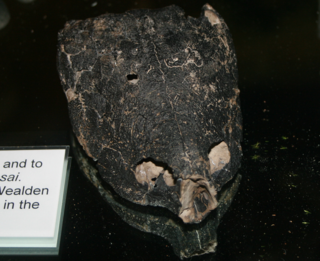
Archelon is an extinct marine turtle from the Late Cretaceous, and is the largest turtle ever to have been documented, with the biggest specimen measuring 4.6 m (15 ft) from head to tail and 2.2–3.2 t in body mass. It is known only from the Pierre Shale and has one species, A. ischyros. In the past, the genus also contained A. marshii and A. copei, though these have been reassigned to Protostega and Kansastega, respectively. The genus was named in 1895 by American paleontologist George Reber Wieland based on a skeleton from South Dakota, who placed it into the extinct family Protostegidae. The leatherback sea turtle was once thought to be its closest living relative, but now, Protostegidae is thought to be a completely separate lineage from any living sea turtle.

A flipper is a broad, flattened limb adapted for aquatic locomotion. It refers to the fully webbed, swimming appendages of aquatic vertebrates that are not fish.

Dermochelyidae is a family of turtles which has seven extinct genera and one extant genus, including the largest living sea turtles.

Neodiapsida is a clade, or major branch, of the reptilian family tree, typically defined as including all diapsids apart from some early primitive types known as the araeoscelidians. Modern reptiles and birds belong to the neodiapsid subclade Sauria.

Allopleuron is a genus of extinct sea turtle, which measured 2-to-2.5-metre long in life. The type species is Allopleuron hofmanni. It is a basal member of the clade Pancheloniidae, closely related to Protosphargis. Similar to Protosphargis, it was characterized by shell reduction.

Cryptoclididae is a family of medium-sized plesiosaurs that existed from the Middle Jurassic to the Early Cretaceous. They had long necks, broad and short skulls and densely packed teeth. They fed on small soft-bodied preys such as small fish and crustaceans. The earliest members of the family appeared during the early Bajocian, and they represented the dominant group of long-necked plesiosaurs during the latter half of the Jurassic.

Protostegidae is a family of extinct marine turtles that lived during the Cretaceous period. The family includes some of the largest sea turtles that ever existed. The largest, Archelon, had a head one metre (39 in) long. Like most sea turtles, they had flattened bodies and flippers for front appendages; protostegids had minimal shells like leatherback turtles of modern times.

Bothremydidae is an extinct family of side-necked turtles (Pleurodira) known from the Cretaceous and Cenozoic. They are closely related to Podocnemididae, and are amongst the most widely distributed pleurodire groups, with their fossils having been found in Africa, India, the Middle East, Europe, North America and South America. Bothremydids were aquatic turtles with a high morphological diversity, indicative of generalist, molluscivorous, piscivorous and possibly herbivorous grazing diets, with some probably capable of suction feeding. Unlike modern pleurodires, which are exclusively freshwater, bothremydids inhabited freshwater, marine and coastal environments. Their marine habits allowed bothremydids to disperse across oceanic barriers into Europe and North America during the early Late Cretaceous (Cenomanian). The youngest records of the group are indeterminate remains from Saudi Arabia and Oman, dating to the Miocene.
Corsochelys is an extinct genus of sea turtle that lived in the Late Cretaceous (Campanian). Zangerl (1960) named the type species, based upon remains found in Alabama within the Mooreville Chalk Formation.

Toxochelys is an extinct genus of marine turtle from the Late Cretaceous period. It is the most commonly found fossilized turtle species in the Smoky Hill Chalk, in western Kansas.

Bouliachelys is an extinct genus of sea turtle from Cretaceous Australia. It was originally described as a member of Protostegidae. In 2013 study it was considered to be a member of Dermochelyoidae, although later studies consider it as a protostegid again.

Desmatochelys is an extinct genus of sea turtles belonging to the family Protostegidae. This genus contains two known species, D. lowii and D. padillai. D. lowii was first discovered in 1895, followed by D. padillai in 2015. Having been estimated at over 120 million years old, D. padillai is currently the oldest known species of sea turtle.

Ocepechelon is an extinct genus of giant protostegid sea turtle known from Late Cretaceous phosphatic deposits of the Oulad Abdoun Basin, Khouribga Province of Morocco. It is known from the holotype OCP DEK/GE 516, a complete but isolated 70-cm-long skull, making it one of the largest marine turtles ever described. It was first named by Nathalie Bardet, Nour-Eddine Jalil, France de Lapparent de Broin, Damien Germain, Olivier Lambert and Mbarek Amaghzaz in 2013, and the type species is Ocepechelon bouyai. The feeding apparatus of Ocepechelon, a bony pipette-like snout, is unique among tetrapods and shares unique convergences with both syngnathid fishes and beaked whales.

Panchelonioidea is a clade of marine turtles that includes the sea turtles and related taxa.

Pervushovisaurus is a genus of platypterygiine ichthyosaur from the Late Cretaceous (Cenomanian) of the Saratov region in western Russia, the La Penthiève Beds of France and the Cambridge area of the UK.

The Helochelydridae are an extinct family of stem-turtles known from fossils found in North America and Europe spanning the Early to Late Cretaceous.

Alienochelys is an extinct genus of sea turtle known from Maastrichian-aged Cretaceous phosphates in Morocco. With a skull measuring 41.5 centimetres (1.36 ft) long, it would have been a very large turtle. It was first described as a member of the family Dermochelyidae, meaning that it is a relative of the modern leatherback turtle, though a 2018 study identifies it as a sister taxon of Ocepechelon belonging to the family Protostegidae, indicating that it may have been closer to the extinct Archelon. Unlike other sea turtles, Alienochelys' the jaws being adapted for a powerful crushing pattern well adapted for a durophagous lifestyle, as well as its unusual cranial characteristics.
This list of fossil reptiles described in 2019 is a list of new taxa of fossil reptiles that were described during the year 2019, as well as other significant discoveries and events related to reptile paleontology that occurred in 2019.
This list of fossil reptiles described in 2020 is a list of new taxa of fossil reptiles that were described during the year 2020, as well as other significant discoveries and events related to reptile paleontology that occurred in 2020.
This list of fossil reptiles described in 2016 is a list of new taxa of fossil reptiles that were described during the year 2016, as well as other significant discoveries and events related to reptile paleontology that occurred in 2016.















